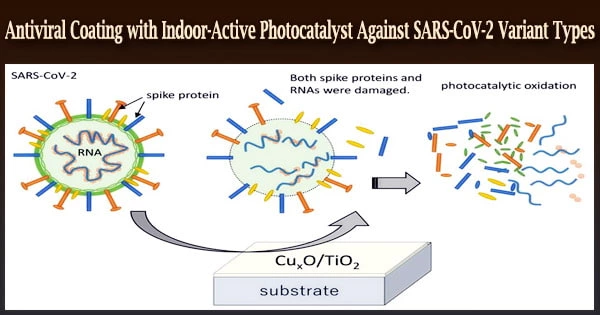A photocatalyst constructed from a mixture of titanium dioxide (TiO2) inactivates the new coronavirus SARS-CoV-2 and copper oxide (CuxO) nanoclusters.
In a recent accomplishment, scientists from Nara Medical University, Kanagawa Institute of Industrial Science and Technology, and Tokyo Institute of Technology discovered an antiviral photocatalyst that has been demonstrated to work in both darkness and indoor light.
The new coronavirus (SARS-CoV-2) have impacted millions of people, which is responsible for the continuing COVID-19 pandemic. The virus is primarily transmitted through droplets discharged into the air by infected people.
These droplets can also be seen on a variety of surfaces. Viral infections are most common in enclosed spaces with a large number of people. Alcohol and hydrogen peroxide, both antiviral agents, are frequently employed to clean frequently touched surfaces.
By breaking down the virus’s proteins, these chemicals effectively render it inert. These compounds, on the other hand, are volatile in nature and thus evaporate. As a result, disinfection must be performed on a frequent basis.
A research team from Nara Medical University, Kanagawa Institute of Industrial Science and Technology, and Tokyo Institute of Technology has created a solid-state photocatalyst as alternate protection against the virus, according to a paper published in Scientific Reports.
Solid-state coatings, unlike chemical disinfectants, last a long time and have been the subject of extensive research around the world since the virus outbreak. Non-toxic, plentiful, and chemically and thermally stable solid-state antiviral coatings have a number of advantages.
Many of these solid-state coatings contain TiO2 photocatalysts, which initiate an oxidation reaction when exposed to UV light, which can degrade organic matter such as the spike proteins seen on coronavirus surfaces.
These coatings, on the other hand, are only active when exposed to UV radiation, which is not present in most indoor contexts. Because most indoor illumination is turned off at night in most environments, it sought antiviral material in a dark atmosphere.
The scientists created a composite comprised of TiO2 and CuxO nanoclusters to make the coating work in both visible and dark light. CuxO nanoclusters are made up of a mixed-valence number oxide that contains both Cu(I) and Cu(II) species.
The Cu(I) species in CuxO contributes to the visible-light-driven photocatalysis reaction, whereas the Cu(I) species is important for denaturing virus proteins and inactivating them in dark conditions.
The team demonstrated that putting the CuxO/TiO2 powder on glass might inactivate even the extremely virulent Delta version of SARS-CoV-2. In addition to the wild-type strain, the research has confirmed that CuxO/TiO2 inactivates Alfa, Beta, and Gamma variations.
Using sodium dodecyl sulfate-polyacrylamide gel electrophoresis (SDS-PAGE), an ELISA assay, and RT-qPCR analysis, the team extensively explored the antiviral mechanism.
These findings strongly show that the Cu(I) species in CuxO denaturalizes spike proteins and also causes SARS-CoV-2 RNA fragmentation, even in the dark. White light irradiation also triggers the photocatalytic oxidation of SARS-organic CoV-2’s compounds.
The current antiviral material is not limited to a single virus variant and will be efficient in inactivating numerous sorts of a future mutant strain based on this antiviral mechanism.
In the current investigation, it used white light illumination as an interior light source. As a result, the CuxO/TiO2 photocatalyst may be particularly effective at reducing the risk of COVID-19 infection in indoor situations that are frequently exposed to both light and darkness.
Hopefully, this research will help us get one step closer to better defending ourselves from the coronavirus and adjusting to life after COVID.





